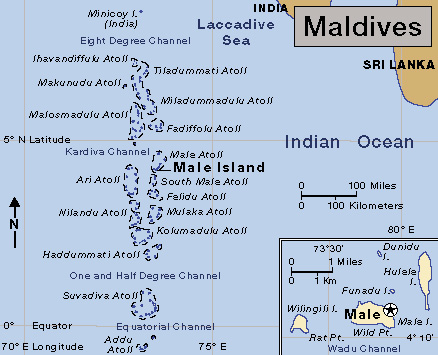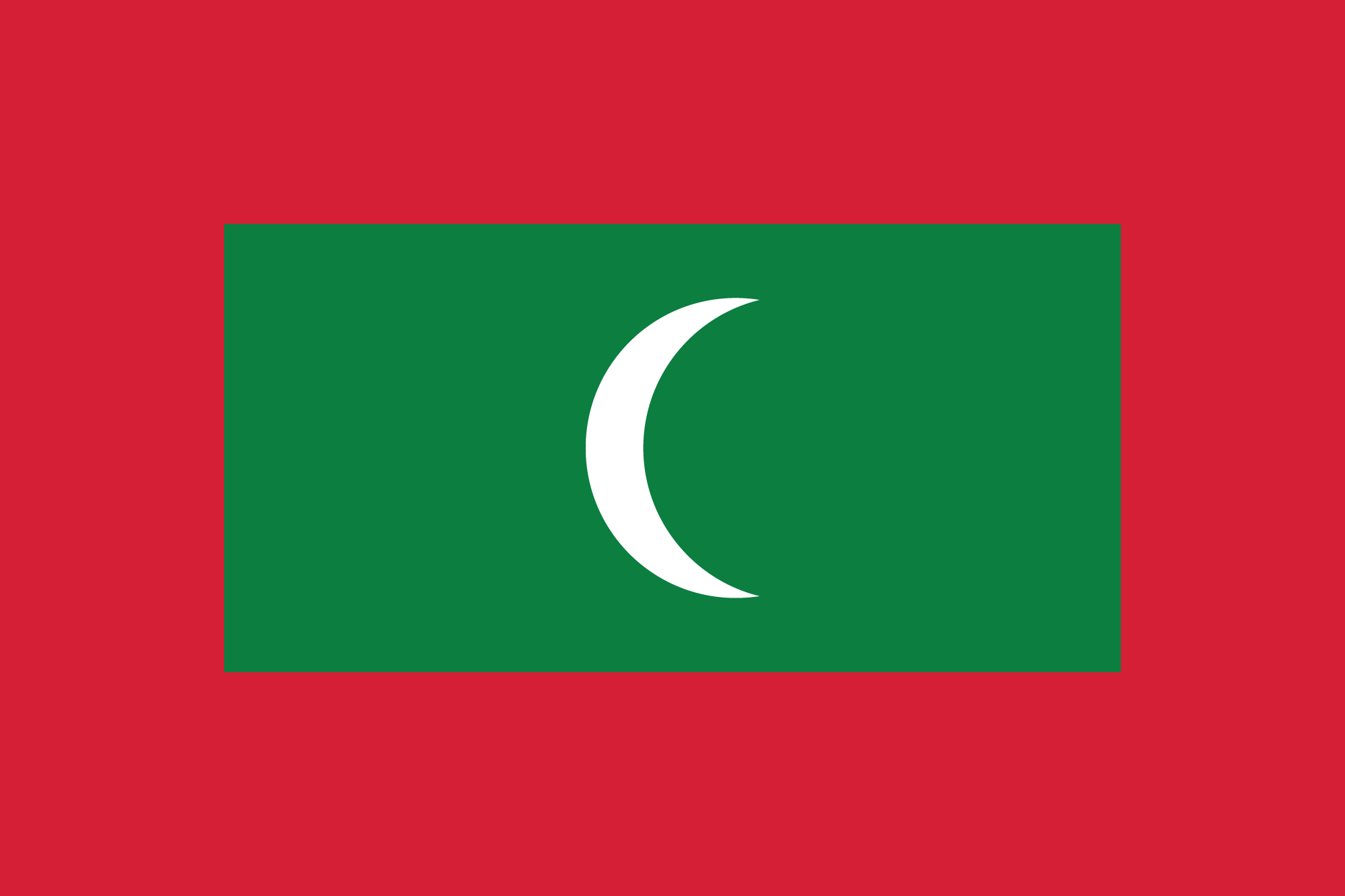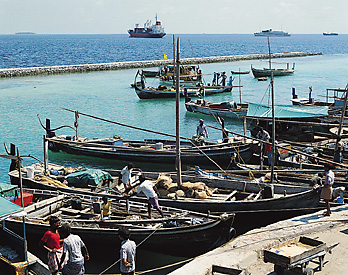Maldives << MAWL deevz or MAL dyvz >> is the smallest independent country in Asia and one of the smallest in the world. It consists of about 1,200 small coral islands that form a chain 475 miles (764 kilometers) long and 80 miles (129 kilometers) wide in the Indian Ocean. The northern tip of the Maldives is about 370 miles (595 kilometers) south of India. These tropical islands cover a total of only 115 square miles (298 square kilometers). Fishing and tourism are the main economic activities.

The United Kingdom governed the Maldives as a protectorate for 78 years. The islands became independent in 1965. The official language is Dhivehi, and the country’s name in that language is Dhivehi Raajjeyge Jumhooriyyaa (Republic of Maldives). Male is the capital and largest city.
Government.
The Maldives is a republic. The president, who is head of the government, is elected by popular vote to a five-year term and cannot serve more than two terms. The voters also elect the members of the People’s Majlis (legislature) to five-year terms. The president appoints a cabinet to help run the government. An elected committee handles local government on each atoll (cluster of islands). The government appoints a kateeb (head official) for each island. A chief justice appointed by the president administers the laws. Law in the Maldives is based on the Sunni Muslims’ code of law.

People.
Most Maldivians are descendants of Sinhalese people who came from Sri Lanka. Some Maldivians are descendants of people from southern India and of Arab traders and sailors. Almost all Maldivians belong to the Sunni division of Islam. Maldivians live on only about 200 of the country’s islands. About 80 islands are reserved for tourists.
Many Maldivians go to sea every day in boats to catch fish. Most build their boats of coconut or other timber that grows on the islands. Each boat can hold about a dozen crew members. The fishing crews sail 15 or 20 miles (24 or 32 kilometers) out from the islands and catch bonito, tuna, and other fish. Most of the fish are exported to Japan and Sri Lanka.
Fish is the primary food of the people of Maldives. They also eat coconuts, papayas, pineapples, pomegranates, and sweet potatoes.
Land.
The 1,200 small islands are grouped together in about 13 major clusters called atolls. Barrier reefs around the atolls help protect the islands from the sea.
None of the islands covers more than 5 square miles (13 square kilometers), and most are much smaller than that. Most are like little platforms about 6 feet (1.8 meters) above sea level. An 8-foot (2.4-meter) elevation on Wilingili Island is the highest point. The islands have clear lagoons and white sand beaches. The land is covered with grass and low-growing tropical plants. Coconut palms and fruit trees grow on the islands.
The climate is hot and humid. Daytime temperatures average about 80 °F (27 °C). The northern islands receive at least 100 inches (250 centimeters) of rain a year, and those in the south receive almost 150 inches (381 centimeters). Two monsoons (seasonal winds) blow over the islands each year and bring most of the rain.
Economy
of the Maldives depends largely on fishing and tourism. Tuna is the country’s main fishing catch. Over a million tourists, mainly from Europe and China, visit the Maldives each year.

Maldivians raise bananas, coconuts, and papayas. However, most of the country’s food needs to be imported. Craftworkers use the coconut husk fibers, called coir, to make yarn and ropes. The country’s main manufactured products include boats, handicrafts, and processed foods.
The country imports more than it exports. Food and petroleum are major imports. Fish and fish products account for almost all of the Maldives’s exports. China, Singapore, Sri Lanka, Thailand, and the United Arab Emirates are important trading partners.
Male has most of the country’s paved roads. It also has an international airport and the country’s main port.
History.
Little is known about the early history of the Maldives, but people have lived there for thousands of years. The islands came under Portuguese rule during the 1500’s. From 1656 to 1796, the Dutch ruled the islands. In 1887, the Maldives officially became a British protectorate. The Maldives had internal self-government, but the United Kingdom handled foreign affairs.
In the 1950’s, a dispute between the Maldivians and the British over an air base on Gan Island led to the secession (withdrawal) of three southern atolls. The Maldivian government accused the United Kingdom of backing the rebellion, which it crushed in 1960. That same year, the United Kingdom and the Maldives signed an agreement that gave the British free use of the Gan Island base. The Maldivians received the right to conduct most of their foreign affairs and about $2 million for economic development. In 1965, the United Kingdom and the Maldives signed a new agreement that gave the islands complete independence.
The Maldives became a republic in November 1968. In 1976, the British withdrew from the Gan Island air base. The Maldives joined the Commonwealth of Nations in 1982. In 1985, the Maldives and other South Asian countries established the South Asian Association for Regional Cooperation (SAARC), an organization that deals with social and economic issues.
In December 2004, a powerful undersea earthquake in the Indian Ocean near the Indonesian island of Sumatra generated a series of large ocean waves called a tsunami. The tsunami’s towering waves killed more than 80 people in the Maldives and caused enormous amounts of damage to property and natural resources.
In August 2007, voters in a referendum (public vote) decided that a new constitution should allow for direct presidential elections. In 2008, the Constitution was ratified and democratic reformer Mohammed Nasheed was elected to the presidency. He defeated long-ruling President Maumoon Abdul Gayoom. In 2012, Nasheed resigned from office in the face of growing protests by Gayoom’s supporters.
Abdulla Yameen was elected president in 2013. In the following years, the Commonwealth of Nations investigated allegations that Nasheed had been overthrown in a coup and that the new government was corrupt and undermining democracy in the Maldives. In 2016, the country withdrew from the Commonwealth of Nations.
In 2018, Ibrahim Mohamed Solih was elected president. He soon began a program of democratic political reform. The Maldives rejoined the Commonwealth of Nations in 2020. Mohamed Muizzu was elected president of the Maldives in 2023.
See also Chola Empire; Colombo Plan; Male; South Asian Association for Regional Cooperation (SAARC).
